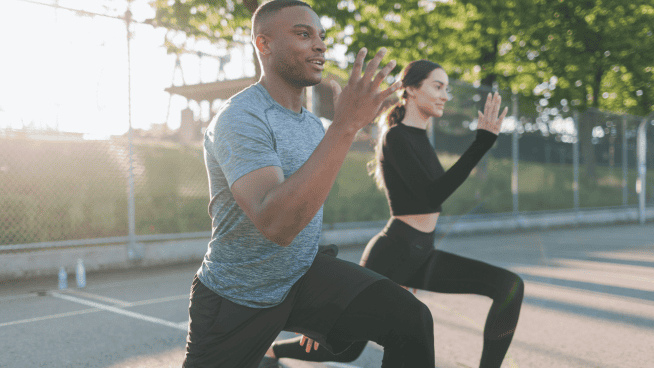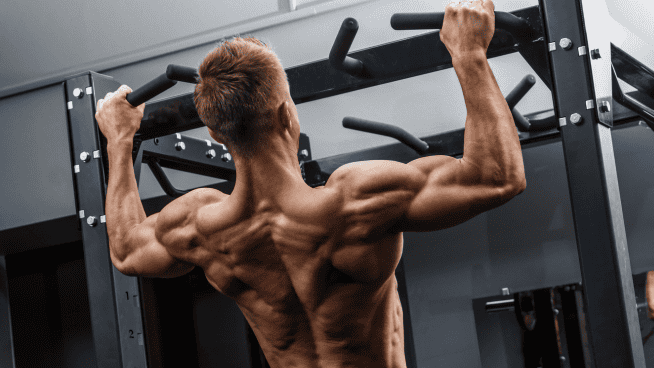Jump Higher With These 10 Tips You’ve Never Tried Before
For some athletes, vertical jump height is a major pain point.
Everyone wants to jump higher, and when no one’s proud of a weak vert.
Those with the right DNA can increase their vertical by simply jumping more.
But for most athletes, this isn’t the case.
However, even if Michael Jordan-esque hops aren’t in your genetics, there are still ways you can build a truly impressive vertical jump.
I don’t believe I was born as a great jumper, but through the use of smart training techniques, I now boast a vertical of almost 40 inches.
Most people can’t jump high because they simply don’t know the best way to train the ability.
With that in mind, here are 10 tips I’ve used to increase my own vert and help many athletes dunk.
1. Jump With Your Hips
A study in Ergonomics found that, among soccer players, high performers in the vertical jump use a more hip-dominant strategy than low performers. The difference was 4.3 inches! Differences of joint movements at the knee were not found between the groups, suggesting that the hips were the big difference-maker.
When descending, load the hips by sitting back. This allows you to more effectively use the large, powerful muscles of the hips as you explode into your jump.
2. Strengthen the Hips
A study in the British Journal of Sports Medicine found a strong correlation between maximal strength in Half Squats and jumping height. This suggests that the major muscles involved in the Half Squat (glutes, adductor magnus and hamstrings) should be trained to maximize jump height.
Train the lower body with Squats, Deadlifts and Split Squats to build the hip extensor muscles. Prioritizing Split Squats could be of benefit as one study found they activated the gluteus medius and hamstrings to a greater extent than normal Squats. Another study found the hamstrings are activated better in the Rear Foot Elevated Split Squat than during Back Squats.
3. Strengthen the Big Toe Muscle
A study in the Journal of Physical Therapy Science found a high correlation between the strength of the big toe flexor muscle and countermovement jump height. Researchers speculated that weak big toe strength leads to energy loss at the ankle joint, resulting in less explosive movements.
You can strengthen this flexor muscle area by pushing through the big toe when jumping and sprinting. In the weight room, you can curl the big toe through the ground when coming upward on a Squat or Deadlift.
4. Train the Spinal Erectors
A study in the Journal of Sports Sciences found that the erector spinae act as a trunk extensor during a vertical jump, enabling more muscle work and causing a greater jump height.
Train the spinal erectors with Deadlifts, Trap Bar Deadlifts, Good Mornings and Back Extensions. These will strengthen the trunk extensors of the back, helping for more powerful extension into the air.
5. Train the Upper Body
A study in the Journal of Biomechanics found an arm swing increased jump height by an average of 3.386 inches compared to not using an arm swing. A study in the Journal of Strength and Conditioning Research found the addition of the arm swing causes greater benefit to men than women. The researchers speculated this was because of increased upper body strength.
Train the upper body for strength with push-pull exercises (Bench Press, Rows, Pull-Ups and overhead presses). You can also train for the arm swing action by performing Med Ball Slams and Med Ball Overhead Throws.
6. Combine Strength Training with Plyometrics
A study in The Journal of Sports Medicine and Physical Fitness found that “scientific evidence suggests that the best way to improve VJP (Vertical Jump Performance) is through the combination of PT (Plyometric Training) with WT (Weight Training).”
Perform a combination of strength and power-type training. Complex and contrast circuits are a great way to cover this. French contrast training is an excellent way to build more explosive jumps:
7. Train Your Core and Hips to Avoid Knee Injury
A study in the Journal of Athletic Training found that volitional abdominal contraction prior to a landing created a protective advantage to the ACL. Core training that strengthens the core and hips allows for greater control of the pelvis during landings. This pelvic control helps with knee stabilization, protecting against injuries.
A sore knee will prevent you from jumping high and training to jump higher. To help protect your knees, train for core stability. Anti-rotation, flexion and extension-based exercises should be used to optimize control of the hip and knee on landing.
8. Use Concentric-Only Training
A study in the Journal of Physiology found that concentric actions involve a faster rate coding than eccentric actions. This essentially means it builds up fast twitch fibers more effectively and allows for quick force production ( which is needed for a high vertical jump).
Perform some concentric-only lifting in your workouts. This means starting from a deadstop on Deadlifts and DB Rows. For presses and squats, this means starting from a deadstop out of the pins. Lifting in this manner ensures fast force production and recruitment of fast twitch fibers.
9. Individualize Your Training to Your Needs
A study in Frontiers in Physiology found that optimizing training to velocity- and force-deficits led to greater increases in jump height than a well-balanced plan. For those athletes with a velocity-deficit (strong but move slow), speed training leads to positive results. For those athletes with a force-deficit (move fast but weak), strength training leads to positive results.
Find out what your weakness is (strength or speed) and train that ability. You can use force-velocity profiling to get this done or use your own judgement. If you are average at everything, then use a combination of strength and speed training.
10. Take Caffeine
A study in the Journal of Strength and Conditioning Research found that caffeine increased countermovement jump height versus a placebo (36.4 ± 6.9 vs. 37.9 ± 7.4 cm). Consume caffeine if you want a short-term gain in vertical jump performance. The subjects in the study consumed 5mg/kg body weight 60 minutes before testing.
READ MORE:
RECOMMENDED FOR YOU
MOST POPULAR
Jump Higher With These 10 Tips You’ve Never Tried Before
For some athletes, vertical jump height is a major pain point.
Everyone wants to jump higher, and when no one’s proud of a weak vert.
Those with the right DNA can increase their vertical by simply jumping more.
But for most athletes, this isn’t the case.
However, even if Michael Jordan-esque hops aren’t in your genetics, there are still ways you can build a truly impressive vertical jump.
I don’t believe I was born as a great jumper, but through the use of smart training techniques, I now boast a vertical of almost 40 inches.
Most people can’t jump high because they simply don’t know the best way to train the ability.
With that in mind, here are 10 tips I’ve used to increase my own vert and help many athletes dunk.
1. Jump With Your Hips
A study in Ergonomics found that, among soccer players, high performers in the vertical jump use a more hip-dominant strategy than low performers. The difference was 4.3 inches! Differences of joint movements at the knee were not found between the groups, suggesting that the hips were the big difference-maker.
When descending, load the hips by sitting back. This allows you to more effectively use the large, powerful muscles of the hips as you explode into your jump.
2. Strengthen the Hips
A study in the British Journal of Sports Medicine found a strong correlation between maximal strength in Half Squats and jumping height. This suggests that the major muscles involved in the Half Squat (glutes, adductor magnus and hamstrings) should be trained to maximize jump height.
Train the lower body with Squats, Deadlifts and Split Squats to build the hip extensor muscles. Prioritizing Split Squats could be of benefit as one study found they activated the gluteus medius and hamstrings to a greater extent than normal Squats. Another study found the hamstrings are activated better in the Rear Foot Elevated Split Squat than during Back Squats.
3. Strengthen the Big Toe Muscle
A study in the Journal of Physical Therapy Science found a high correlation between the strength of the big toe flexor muscle and countermovement jump height. Researchers speculated that weak big toe strength leads to energy loss at the ankle joint, resulting in less explosive movements.
You can strengthen this flexor muscle area by pushing through the big toe when jumping and sprinting. In the weight room, you can curl the big toe through the ground when coming upward on a Squat or Deadlift.
4. Train the Spinal Erectors
A study in the Journal of Sports Sciences found that the erector spinae act as a trunk extensor during a vertical jump, enabling more muscle work and causing a greater jump height.
Train the spinal erectors with Deadlifts, Trap Bar Deadlifts, Good Mornings and Back Extensions. These will strengthen the trunk extensors of the back, helping for more powerful extension into the air.
5. Train the Upper Body
A study in the Journal of Biomechanics found an arm swing increased jump height by an average of 3.386 inches compared to not using an arm swing. A study in the Journal of Strength and Conditioning Research found the addition of the arm swing causes greater benefit to men than women. The researchers speculated this was because of increased upper body strength.
Train the upper body for strength with push-pull exercises (Bench Press, Rows, Pull-Ups and overhead presses). You can also train for the arm swing action by performing Med Ball Slams and Med Ball Overhead Throws.
6. Combine Strength Training with Plyometrics
A study in The Journal of Sports Medicine and Physical Fitness found that “scientific evidence suggests that the best way to improve VJP (Vertical Jump Performance) is through the combination of PT (Plyometric Training) with WT (Weight Training).”
Perform a combination of strength and power-type training. Complex and contrast circuits are a great way to cover this. French contrast training is an excellent way to build more explosive jumps:
7. Train Your Core and Hips to Avoid Knee Injury
A study in the Journal of Athletic Training found that volitional abdominal contraction prior to a landing created a protective advantage to the ACL. Core training that strengthens the core and hips allows for greater control of the pelvis during landings. This pelvic control helps with knee stabilization, protecting against injuries.
A sore knee will prevent you from jumping high and training to jump higher. To help protect your knees, train for core stability. Anti-rotation, flexion and extension-based exercises should be used to optimize control of the hip and knee on landing.
8. Use Concentric-Only Training
A study in the Journal of Physiology found that concentric actions involve a faster rate coding than eccentric actions. This essentially means it builds up fast twitch fibers more effectively and allows for quick force production ( which is needed for a high vertical jump).
Perform some concentric-only lifting in your workouts. This means starting from a deadstop on Deadlifts and DB Rows. For presses and squats, this means starting from a deadstop out of the pins. Lifting in this manner ensures fast force production and recruitment of fast twitch fibers.
9. Individualize Your Training to Your Needs
A study in Frontiers in Physiology found that optimizing training to velocity- and force-deficits led to greater increases in jump height than a well-balanced plan. For those athletes with a velocity-deficit (strong but move slow), speed training leads to positive results. For those athletes with a force-deficit (move fast but weak), strength training leads to positive results.
Find out what your weakness is (strength or speed) and train that ability. You can use force-velocity profiling to get this done or use your own judgement. If you are average at everything, then use a combination of strength and speed training.
10. Take Caffeine
A study in the Journal of Strength and Conditioning Research found that caffeine increased countermovement jump height versus a placebo (36.4 ± 6.9 vs. 37.9 ± 7.4 cm). Consume caffeine if you want a short-term gain in vertical jump performance. The subjects in the study consumed 5mg/kg body weight 60 minutes before testing.
READ MORE:












